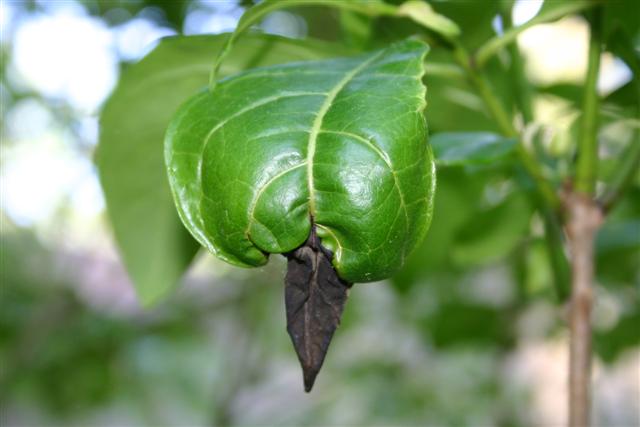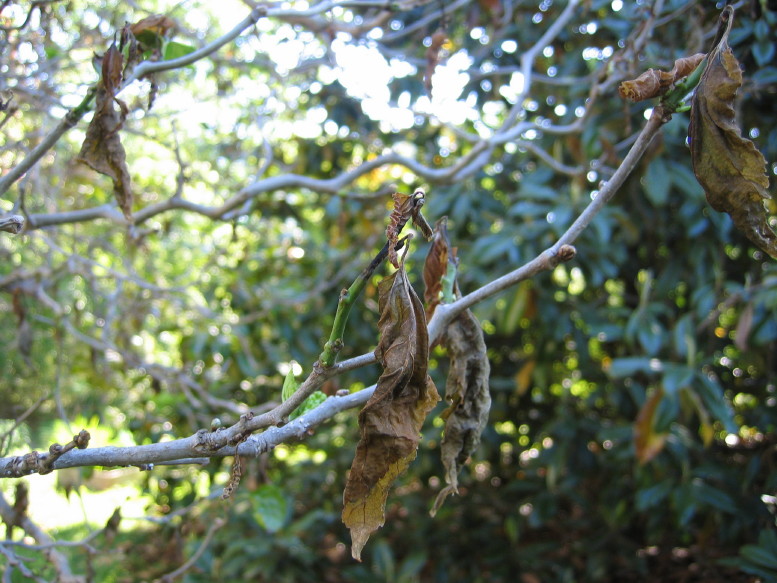Georgia Gardener Newsletter Design Tip: May 3, 2007
| Easter Weekend Freeze Follow-up |
We are now about four weeks past the several days of hard freezing weather that we had over the Easter weekend in early April. Many plants have
suffered freeze damage but are responding. Others seem to be slow to bounce back. Below are some common landscape plants that may have
suffered and what you need or don't need to do.
Hydrangeas
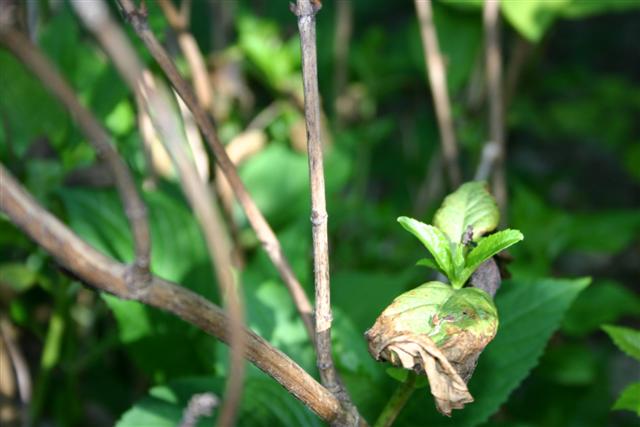
|
| Hydrangea that was frozen back severely |
By now all hydrangeas that were damaged should be showing signs of recovery. Any branch tips that do not have leaves emerging by now
are dead and should be cut back to the first healthy leaves. Mophead Hydrangeas (H. macrophylla) may not bloom this year. The
exceptions being those repeat-blooming varieties such as 'Endless Summer'. These hydrangeas will bloom but may be a bit late.
Oakleaf, Annabelle, Tardiva and Pee Gee Hydrangeas seemed to have weathered the freeze better, but if they have branch dieback,
prune these also. Since Annabelle, Tardiva and Pee Gee Hydrangeas bloom on new growth, flowering should not be greatly impacted.
Chaste Trees (Vitex)
Chaste trees took the freeze surprisingly hard and some have significant dieback. Any branches or branch tips not showing new growth
should be pruned. Chaste trees also bloom on new growth and I'm hoping that the flowering may only be delayed but not destroyed. Any
chaste trees that suffered severely may not bloom at all this year; some may have died outright.
Japanese Maples, Hollies, Gardenias, Loropetalums (and other shrubs)
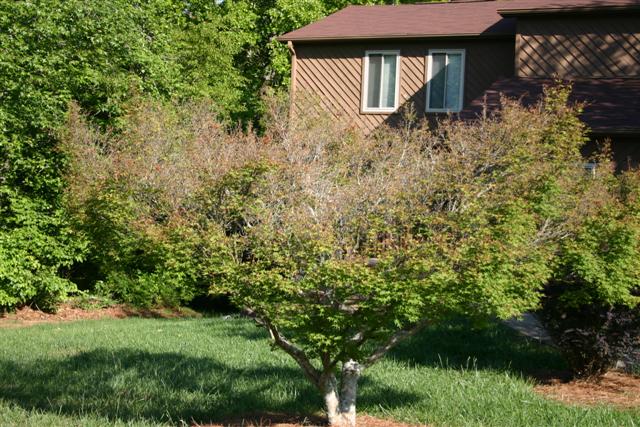
|
| Japanese Maple with tip damage
|
Treat these plants just like the Chaste trees. If the branches or tips show no signs of life, go ahead and prune them back.
Crape Myrtles
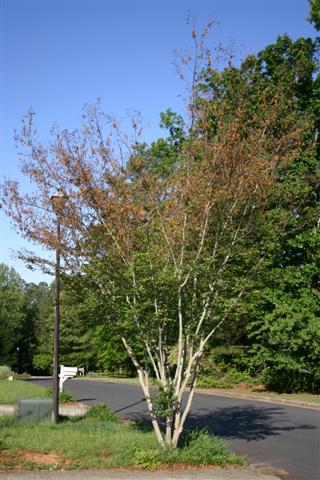
|
| Crape Myrtle with foliage damage at the top
|
I'm surprised at how slow many Crape Myrtles have been to bounce back from the freeze. Unlike some of the plants listed above,
I'm recommending that you wait another 1-2 weeks before taking action. Those CMs that were pruned prior to the freeze had almost
every leaf blackened by the cold weather. These trees seem to be slower to recover than those that had not been pruned. The CM in the
picture above was NOT pruned this past winter and looks a lot better than others. If you absolutely feel the need to do something, you
can hand pick the dead leaves.
Evergreen Clematis (armandii) Vines
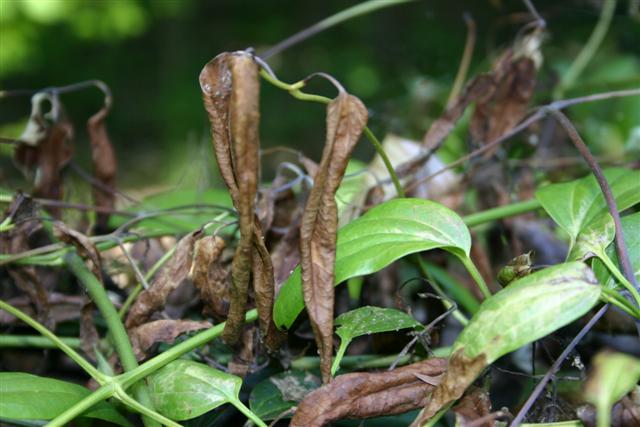
|
| Clematis armandii with foliage damage
|
Most of the evergreen Clematis vines were in near to full bloom when the freeze hit. At first, I thought the vines had come through
unscathed. However, the damage was delayed and is now appearing. The flowers seemed unhurt and blooming came to its normal conclusion but
the new growth was singed. You may want to perform some minor nip and tuck pruning to remove any blackened foliage.
Roses
The repeat-blooming roses such as Knockout and its cousins were barely phased by the cold. The new foliage that was emerging and any buds
that were swollen were probably damaged. However, these are such prolific growers and bloomers, they will have no trouble recovering. Some
older varieties of roses, especially those that only bloom once may have suffered some bloom damage. Remove any damaged foliage, branches
or blooms at this time.
Hardwoods: Oaks, Maples, Sweetgums, etc.
Many of these trees lost most if not all of their early foliage and in the north Georgia mountains, they have dropped their leaves
entirely giving the area a winter appearance. There may be some branch tip dieback. I plan to do minimal maintenance or nothing at all
as these trees will self-prune any damaged branches and leaves. New leaves will and are already emerging.
On the upside, sweetgums were in full bloom when the freeze hit so we
should see a reduction in those annoying sweetgum balls this summer. Oaks, hickories and pecans may also have diminished nut
production.
Other trees such as Dogwoods, Cherries and Redbuds which were in bloom or had bloomed just prior to the freeze will probably have a reduction
in fruit or seeds this fall.
Hostas and other Perennials
Some hostas were moderately to severly burned by the frost. My recommendation is to only remove the damaged portions of the leaves and not
the entire leaf. This is also true for other perennials and ferns.
Figs, Blueberries, Apples, Pears and Peaches
Fruit-bearing trees and shrubs were really hit hard and the commercial crops were either lost or severely damaged. Look for
increased prices for these products this summer. Prune any tip dieback on these plants at this time and remove any damaged fruit.
Oddly, blackberries, raspberries and muscadines seemed to have not suffered greatly, at least in my garden.
Summer Annuals and Vegetables
If you were tempted and planted your summer annuals and vegetables before the recommended April 15 date,
then many of these are dead or damaged beyond
repair. You are probably better off starting over and replacing them. Take heart, we have a long growing season with plenty of time for
flowers and tomatoes.
The Drought Effect
I believe that our worsening drought has played a major role in the slow return of many plants and may have contributed to some being overly
sensitive to the cold temperatures. Plants that were damaged by the frost will need to be lovingly and correctly
watered for the rest of the season.
Plants that seem to be rebounding nicely could use a light dose of fertilizer later this summer.
Copyright © 2007 by Theresa Schrum - All rights reserved
No part of this website may be reproduced without the expressed written permission of Theresa Schrum
